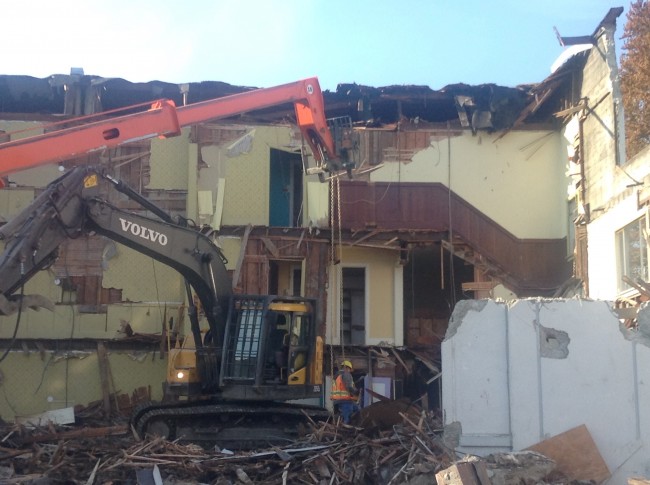
As Max and I passed the old Santa Fe apartments this morning on the way to his preschool – the prim white building that’s having only its facade saved for a new condo tower – I was struck by the sight of a piano, visible on the third floor of the nearly-gutted building. There it was, stranded up there with no way down except perhaps via forklift, since the hallways and stairwells were already torn out.
It was a startling sight, and my immediate thought was to try and save it. We had enough space for it… barely. Christine would’ve loved a real piano in the apartment, and I’d have delighted in rescuing something from a building I’ve been sad to see torn up. It seemed to be just a matter of grabbing it with their long-stemmed forklift and gently setting it down.
I spoke about it to the man in charge, a soft-spoken, bearded fellow named David. He appreciated my interest. He told me he’d played piano from the age of six and felt bad about the piano being destroyed. But he’d run a Craigslist ad, offering it for free, and had no takers. Now, he said, it was probably too late. But he’d see what he could do. He told me the piano, an 80’s model, was in tune and in pretty good shape.
It seemed like it might just come together perfectly. There happened to be a crew of brawny guys doing repair work on our own building, and I figured I could pay them something to help wrangle the piano the one block over and up into our place.
I checked in later, but David said he he’d called around but just couldn’t get the manpower needed to do the job. He was already shorthanded today. In the end it became clear I was fighting a losing battle.
There was some beautiful-looking dark wood wainscoting visible above the piano – angling down alongside where a staircase had been. Why hadn’t it been removed for reuse? It turned out that the lath and plaster of the building had been laid in after the wood panels, which as a result were virtually a part of the building’s structure, and impossible to remove. Apparently there wasn’t any caulking to be found in the building – no such gap-filling techniques were needed when the Santa Fe was built in 1929 (then called the Van Arsdel Apartments). Clearly, they didn’t build with the idea of their work being torn up at a later date. They built stuff to last, virtually forever.
David seemed genuinely regretful about the loss of the piano. It was like burning a book, he said.
I walked by again tonight, and in the gloom I could see that what remained of the Santa Fe’s inside is gone now. And among the jumbled mound of wood scraps below was whatever was left of a fine old piano.
Thanks to Stanley Q Woodvine for some background info in many posts about the Santa Fe on his blog.